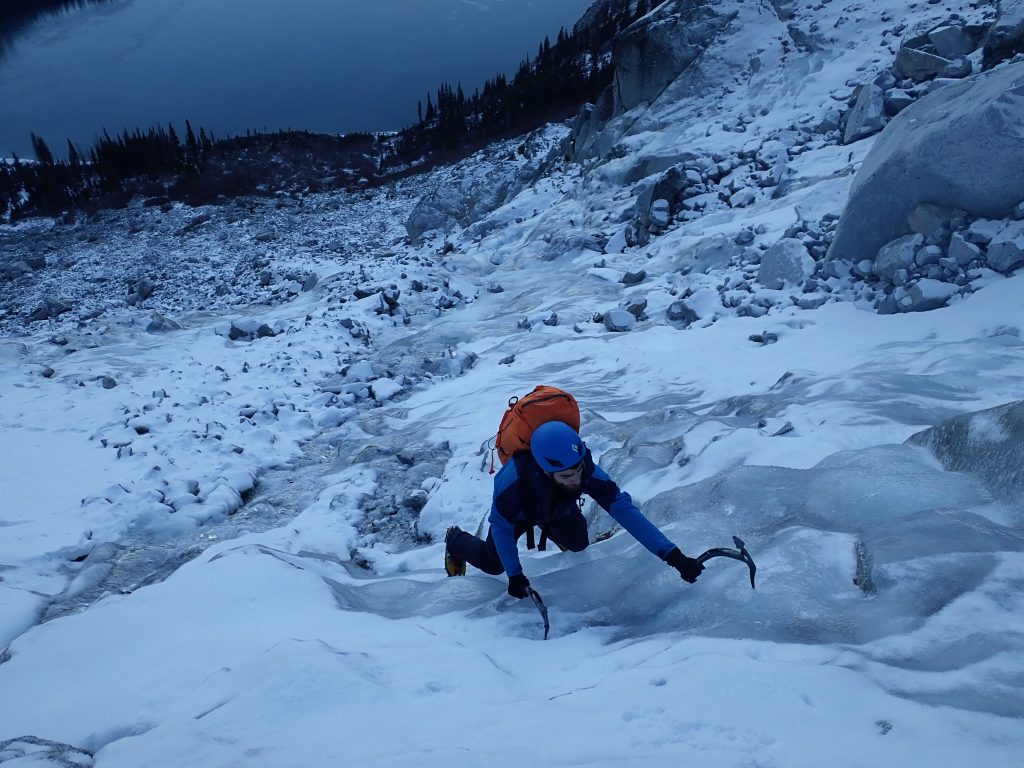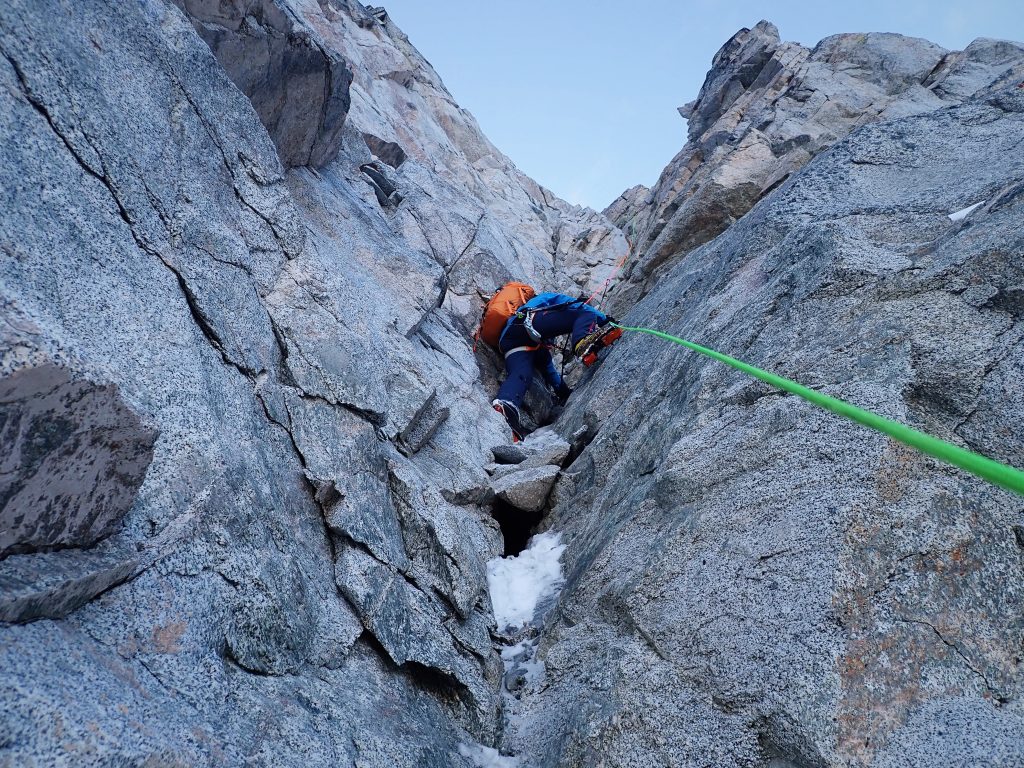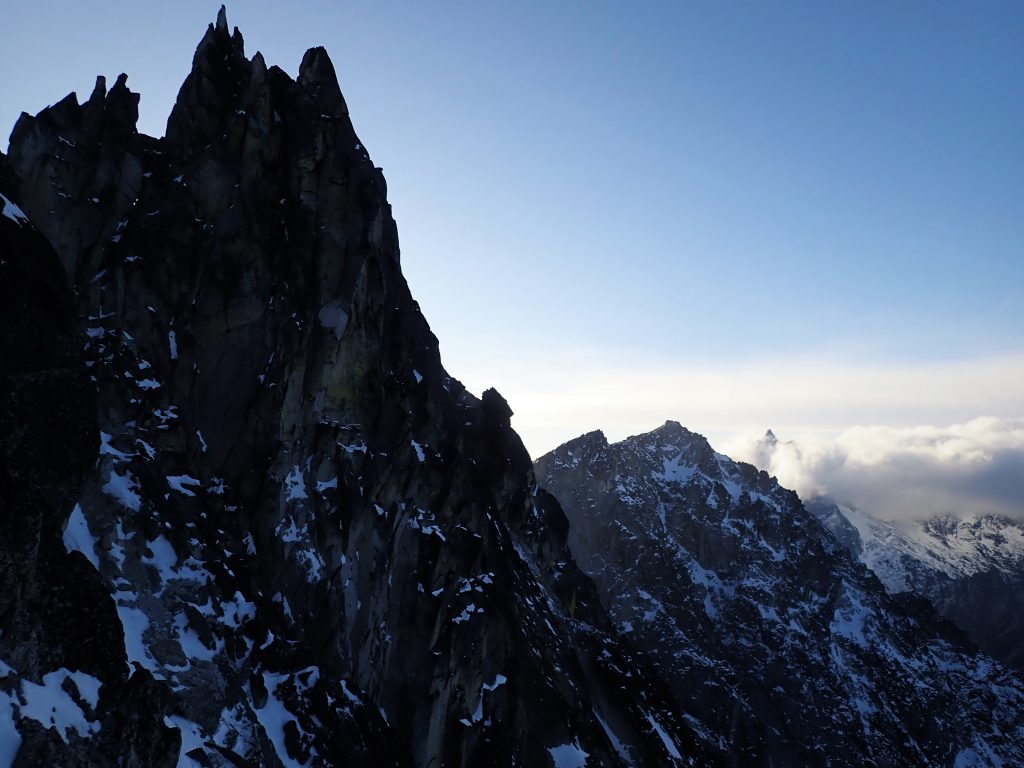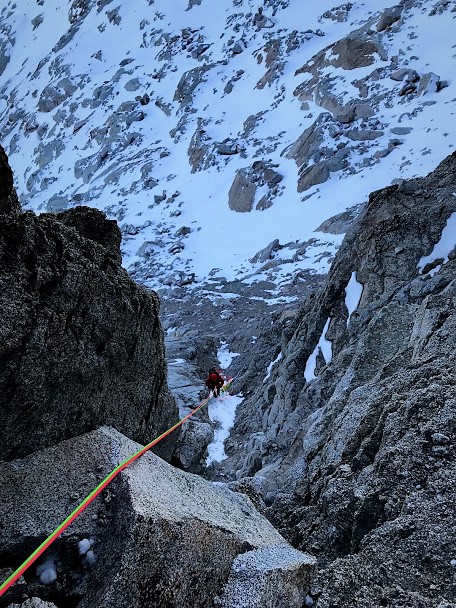The Whole Hotdog
Fall rolls on in the Cascades, but the mountains are still barren and naked. The unusual accessibility of high trailheads and alpine terrain this fall has created great opportunities for alpine ice climbs, like the NW Ice Couloir of Eldorado. After that climb, I began talking to Porter, the guy who inspired me to do Eldo, about potential ice routes to climb together. A weekend came, the weather (sort of) lined up, and so Porter, Daniel, and I decided to return yet again to Colchuck Lake for the NE Couloir of Dragontail. We did not know anything more about this route than a few vague trip reports, but we saw a November trip report and it seemed like it might work.
We left the car around 5 am and hiked in the dark to Colchuck Lake. Daniel and I have done this trail so many times (in the dark) that we have a strong disdain for it, but it was nice to talk to Porter and get to know him better. He is a year younger than us and an incredibly talented climber and runner. It is rare for us to find other “kids” who do things at the same level as us or higher.

At Colchuck Lake, we saw more snow on the faces that we had expected, which was a good sign. The boulder field was mostly snow free, fortunately, and we were able to stay in trail runners until we started heading up Aasgard.


We stayed on the right side of the moraine, while the trail goes to the left side. Pretty quickly, we encountered unavoidable low angle water ice. Most of it we could simply walk up with good technique, but there were a few short WI2- steps here and there. The sticks were hero, so we cruised through it.

The entrance to the couloir was guarded by a series of snow covered slabs. It would probably only be 3rd class if dry, but was a little tricky and crampons.

Daniel and I are very inexperienced at mixed climbing, so Porter graciously offered to set up a handline at the most exposed part. The only problem was that Daniel and I had the ropes in our packs… Woops! Porter managed to string together three cordalettes he had on his harness and this reached down to us, so we could proceed upwards.


Above this, we entered the snowy couloir. I quickly started up, setting the boot pack. The snow alternated between normal shin deep bootpack and bomber snice. Quick, easy vert!



The NE Couloir is an incredibly deep, striking feature. In most places, it is only 10 feet wide or so, but the walls on the sides are hundreds of feet tall! Couloirs have an ability to shrink the world around you to just snow, ice, and rock. As we wound our way up, snaking left and right, Aasgard Pass and the classic Colchuck Lake disappeared from our world.

At the constriction 1/3 of the way up, we made an anchor and put Porter on belay. The crux was an overhung chockstone with a thin ice smear to the side. This was a super fun move that involved thin sticks, some delicated drytooling, and even some stemming!

Above, we once again put away the ropes and continued soloing up sustained 50-60 degree snow, snice, rock, and ice. The quality and variety of climbing was incredible. The snow kept changing from powder to snice, there were easy mixed steps, and plentiful WI2 steps. The movement was so fluid and enjoyable.


Even though the Enchantments are relatively dry, we hypothesized that some of the snow and ice we were climbing was perennial. It just seemed very old in places, mixed in with air and dirt, almost like glacial ice.



Eventually we ran out of snow and decided we need to protect things again.

Behind us, we could see clouds starting to engulf Aasgard Sentinel. Today was a transition day, and high pressure was being replaced by a storm. We could hear the westerly winds whipping the ridges, but we were luckily protected from the wind in this couloir.
Porter led a thoughtful mixed traverse over into another snow couloir and then up easy snow and snice to a belay. We likely could have avoided this pitch if we had taken an earlier right hand fork in the couloir.


The exit notch of the couloir looked so close! But it also looked very dry, drier than we had seen in photos. This was not good. We knew that this would be a very difficult and loose last few pitches, but because of the lack of trip reports, we did not know to the full extent how challenging it would be. Above, we would get whipped by the wind, but at least we thought it was easy traverse to the rappel notch from there? Should we head down? We cold probably downclimb and rappel, but that was no gimmie either. It was a tough decision with no good answer, but ultimately we decided to continue upwards.
Porter led a mixed pitch through a bunch of broken steps and slabs. The climbing was not too difficult mostly, but holds were easily breaking off and protection was scarce. The pitch ended with a challenging mantle with sticks into questionable ice/rock.

The notch was ever closer. But we could also tell that the rock was getting steeper and looser. I could see it in Porter’s eyes that he did not really want to lead this, but sometimes that is the unfortunate nature of alpine climbing.
Porter led upwards and quickly out of view. At one point, I heard him yell “take” which meant two things for certain:
- Porter had a solid piece of protection in.
- The climbing was really, really hard.
As Porter continued on, a constant stream of gravel and ice pellets began to shower Daniel and I at the belay. Pretty quickly, our boots were covered in brown snow and Daniel’s hood was full of ice crystals. But I kept paying out slack bit by bit. We had faith in Porter.
Finally, we heard Porter yell to us that he had reached the notch! Daniel and I looked at each other with relief in our eyes. A few minutes later, Porter had us on belay and we started climbing upwards.
Our strategy was to climb close together so that when (not if) Daniel knocked a loose rock down on me, it would not have much velocity. I took a few rocks to the body, but they were all moving slowly, so no damage was done.

As we got higher, we entered a very sustained mixed corner. The holds were tenuous, breaking off and splintering. The feet were thin, balancing on the tips of our front points. Every movement was earned, nothing was certain. It was some of the burliest climbing both of us have ever done.
I climbed with a single tool in one hand, tapping into inch wide dirt/ice runnels, sticking my crampons wherever they would stick (which was sometimes even the friable rock itself!). It was probably the least elegant climbing I have ever done, and also some of the most purely alpine. It was delightfully desperate, heinous and yet so wickedly fun (at least to follow).

As we stepped through the notch, we were greeted with a blast of cold wind. Porter left us to put away the gear as he headed onwards to find the ledge traverse.

When Daniel and I got going, Porter’s tracks in the snow had already been filled in by the viciously strong gusts. All around us, spindrift swirled like sparkly haze in the afternoon light. Clouds had enveloped the North Cascades, but Stuart, the great guardian directly to our west, was the only thing that stood between us and the abyss.

On adventures like this, there is a certain point where you become fully conscious of the immensity of the moment. We were on a ledge high in the Stuart Range. 2000 ft of technical terrain lay below us. Winter was not days, not hours, but minutes away. Time seemed to slow down, but we knew our pace needed to pick up.

The ledge traverse to the right was fortunately easy, although we periodically were flattened to the ground by 50-60 mph gusts. To reach the rappel notch, there was an easy-looking, but exposed mixed step. Porter was eager to solo it, but Daniel and I voted by majority that we belay this short pitch. As I followed, such a strong gust of wind hit that snow and dirt made its way under my sunglasses, despite that fact I was turned away from the wind. I closed my eyes and groveled upwards.
Once finally at the notch (and slightly out of the bitter winds), we all regrouped. There was an established rappel anchor, and so we tied our ropes together, and I was on my way down to safety.

About 30-40m of rappelling brough me to easy scramble terrain above the Snow Creek Glacier. The other two joined me and we were finally able to breathe a sigh of relief, out of the worst of the wind, and out of technical terrain.

We gazed out at the fading light on McClellan, the Enchantment lakes, and the distant Wenatchee Valley. It is difficult to convey the intensity of an experience like this. Sometimes it feels like this is a different world and a different life that I live. But underneath, I know that I am the same person, and these experiences are just a manifestation of myself in different settings.

Luckily, there was a boot pack for us to follow down towards Aasgard Pass. We could see spindrift rising from the pass so we knew that the peacefulness would not last.


We were once again pummeled by icy spindrift as we started down Aasgard. Sometimes we had to simply turn our backs at the strongest gusts to protect our faces and eyes.
We passed plentiful water ice, some that would make for really fun WI2-3 multipitches. It is easy to see how an unfortunate soul slipped on ice up here a few weeks ago and died. Aasgard in November is serious stuff.

We raced down, trying to get a clear view of the NE Couloir before dark. We got there just in time.

Looking up, the line looked intimidating, steep, and lean. We took a moment to reflect on our decision making. Should we have finished those last two mixed pitches? We had limited information about the difficulty of the climbing, but it did seem like we were facing thinner than usual conditions. Ultimately, we made a decision, not necessarily the right decision, and it worked it out alright. It’s always ambiguous whether your success is due to competence or just plain luck. Alpine climbing is not black and white, but maybe that’s partially what attracts us to it. The decision making, the execution, the team work – it is all a microcosm for life.
We continued down Aasgard and managed to nail the entrance into the brush tunnel that leads to the boulder field. Once back on the trail, it was just the classic death march in the dark back to the car. But the stars were out, the wind died down in the trees, and we once again returned to being just three silly guys in their early 20s.
We arrived back at the car just before 8 pm, making for a solid 15 hr day. The NE Couloir of Dragontail was a tale of two extremes. The majority of the couloir offered some of the best moderate alpine climbing I have ever done, and the finish was some of the worst. For that reason, I cannot recommend this climb in the conditions we climbed it. As Daniel likes to say, it was “the whole hotdog”. It is a shame that those last two pitches are so bad, or else this would be a classic. Nonetheless, I am super grateful to have shared the day with my best friend Daniel and a new friend Porter. Porter was incredible taking all the cruxy leads and staying positive through all the headiness. He is a true Cascade crusher.
Notes:
- We rated the route at WI2, M5 R. The ice climbing was generally easy. Most of the mixed climbing was also reasonable. But those last two pitches were difficult, scary, loose, and runout. M5 R, at least to us.
- We used two short screws, some nuts, and cams from .2-1.
- Obviously, a climb like this is super condition dependent and could range from a lean mixed climb to just a snow couloir in the spring. Don’t expect anything.
- You could avoid the approach ice by taking the trail longer, to the left of the “island” and then cutting back right.
- The rappel probably? would have worked with a single 60 m rope and some easy downscrambling.
- To continue onto the summit looked like a long 5th class ridge scramble.
